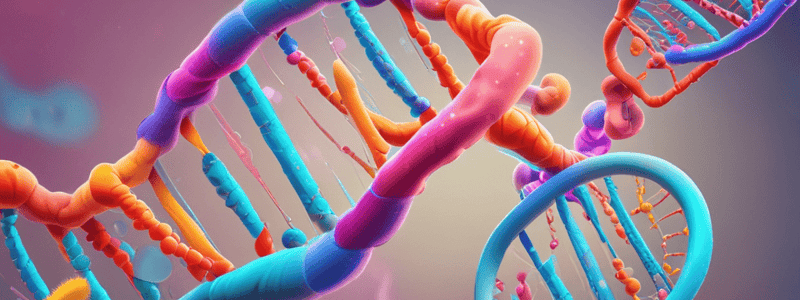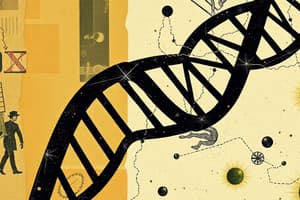Podcast
Questions and Answers
Which of the following best describes the arrangement and nature of nitrogenous bases in DNA strands that allows them to serve as templates for DNA replication?
Which of the following best describes the arrangement and nature of nitrogenous bases in DNA strands that allows them to serve as templates for DNA replication?
- The nitrogenous bases are arranged in a way that allows for multiple possible pairings between the strands.
- The nitrogenous bases are arranged in a specific order, with adenine always pairing with thymine and cytosine always pairing with guanine. (correct)
- The nitrogenous bases are randomly arranged and have no specific pairing patterns.
- The nitrogenous bases are arranged in a way that allows for only one possible pairing between the strands.
Which of the three proposed DNA replication mechanisms was supported by the Meselson-Stahl experiment in bacteria?
Which of the three proposed DNA replication mechanisms was supported by the Meselson-Stahl experiment in bacteria?
- Dispersive replication
- The Meselson-Stahl experiment did not provide evidence for any of the three proposed mechanisms.
- Semiconservative replication (correct)
- Conservative replication
What was the key experimental technique used by Meselson and Stahl to determine the mechanism of DNA replication in bacteria?
What was the key experimental technique used by Meselson and Stahl to determine the mechanism of DNA replication in bacteria?
- Electron microscopy
- Autoradiography
- Genetic transformation
- Buoyant density gradient centrifugation (correct)
What was the significance of the Taylor-Woods-Hughes experiment in eukaryotes?
What was the significance of the Taylor-Woods-Hughes experiment in eukaryotes?
Which of the following is a key difference between DNA replication in prokaryotes and eukaryotes?
Which of the following is a key difference between DNA replication in prokaryotes and eukaryotes?
What is the significance of the complementarity of DNA strands in the process of DNA replication?
What is the significance of the complementarity of DNA strands in the process of DNA replication?
Which of the following is a key characteristic of the dispersive model of DNA replication?
Which of the following is a key characteristic of the dispersive model of DNA replication?
What was the primary purpose of the Taylor-Woods-Hughes experiment in eukaryotes?
What was the primary purpose of the Taylor-Woods-Hughes experiment in eukaryotes?
What is the main function of the enzymes and proteins called replisomes during DNA replication?
What is the main function of the enzymes and proteins called replisomes during DNA replication?
What is the primary role of the DnaA protein during replication initiation in bacteria?
What is the primary role of the DnaA protein during replication initiation in bacteria?
What is the main role of the DnaB helicase during replication initiation in bacteria?
What is the main role of the DnaB helicase during replication initiation in bacteria?
What is the primary function of the single-stranded binding protein (SSB) during DNA replication in bacteria?
What is the primary function of the single-stranded binding protein (SSB) during DNA replication in bacteria?
What is the primary role of the RNA primers during DNA replication?
What is the primary role of the RNA primers during DNA replication?
What is the primary function of the DNA polymerase I (pol I) during DNA replication in bacteria?
What is the primary function of the DNA polymerase I (pol I) during DNA replication in bacteria?
What is the primary function of the topoisomerase enzymes during DNA replication in bacteria?
What is the primary function of the topoisomerase enzymes during DNA replication in bacteria?
What is the main purpose of the origin of replication (oriC) sequence in E. coli bacteria?
What is the main purpose of the origin of replication (oriC) sequence in E. coli bacteria?
What is the purpose of the telomeres at the ends of linear chromosomes?
What is the purpose of the telomeres at the ends of linear chromosomes?
What is the role of telomerase in eukaryotic cells?
What is the role of telomerase in eukaryotic cells?
How are newly replicated DNA molecules organized into nucleosomes?
How are newly replicated DNA molecules organized into nucleosomes?
What is the relationship between telomerase activity and telomere length in eukaryotic cells?
What is the relationship between telomerase activity and telomere length in eukaryotic cells?
What is the purpose of the nucleosomes formed by the wrapping of DNA around histone proteins?
What is the purpose of the nucleosomes formed by the wrapping of DNA around histone proteins?
What is the role of PCNA (proliferating cell nuclear antigen) in the organization of newly replicated DNA?
What is the role of PCNA (proliferating cell nuclear antigen) in the organization of newly replicated DNA?
What is the purpose of the chromatin structure formed by the binding of DNA to histone proteins?
What is the purpose of the chromatin structure formed by the binding of DNA to histone proteins?
What is the role of the CAF-1 (chromatin assembly factor 1) protein in the organization of newly replicated DNA?
What is the role of the CAF-1 (chromatin assembly factor 1) protein in the organization of newly replicated DNA?
What is the primary function of the origin of replication (ORI) in bacterial DNA replication?
What is the primary function of the origin of replication (ORI) in bacterial DNA replication?
In the context of bacterial DNA replication, what does the term 'bidirectional' refer to?
In the context of bacterial DNA replication, what does the term 'bidirectional' refer to?
Based on the information provided, which statement accurately describes the rate of DNA synthesis in E. coli?
Based on the information provided, which statement accurately describes the rate of DNA synthesis in E. coli?
What is a significant difference between DNA replication in bacteria and eukaryotes?
What is a significant difference between DNA replication in bacteria and eukaryotes?
According to the information provided, approximately how many origins of replication are present in the human genome?
According to the information provided, approximately how many origins of replication are present in the human genome?
What is the purpose of having multiple origins of replication in eukaryotic chromosomes?
What is the purpose of having multiple origins of replication in eukaryotic chromosomes?
Based on the information provided, what can be inferred about the relationship between the generation time of E. coli and the rate of DNA replication?
Based on the information provided, what can be inferred about the relationship between the generation time of E. coli and the rate of DNA replication?
What is the approximate distance between origins of replication on eukaryotic chromosomes, as stated in the information provided?
What is the approximate distance between origins of replication on eukaryotic chromosomes, as stated in the information provided?
Which of the following is a function of the 5'-3' exonuclease activity of DNA polymerase III?
Which of the following is a function of the 5'-3' exonuclease activity of DNA polymerase III?
What is the role of the 5'-3' polymerase activity of DNA polymerase III?
What is the role of the 5'-3' polymerase activity of DNA polymerase III?
Which of the following is a key component of the replisome in eukaryotes?
Which of the following is a key component of the replisome in eukaryotes?
What is the role of the origin recognition complex (ORC) in eukaryotic DNA replication?
What is the role of the origin recognition complex (ORC) in eukaryotic DNA replication?
What is the function of the autonomously replicating sequences (ARS) in yeast?
What is the function of the autonomously replicating sequences (ARS) in yeast?
Which of the following statements about eukaryotic DNA replication is correct?
Which of the following statements about eukaryotic DNA replication is correct?
What is the role of the helicase enzyme in eukaryotic DNA replication?
What is the role of the helicase enzyme in eukaryotic DNA replication?
What is the purpose of having multiple origins of replication in eukaryotic chromosomes?
What is the purpose of having multiple origins of replication in eukaryotic chromosomes?
Flashcards are hidden until you start studying




